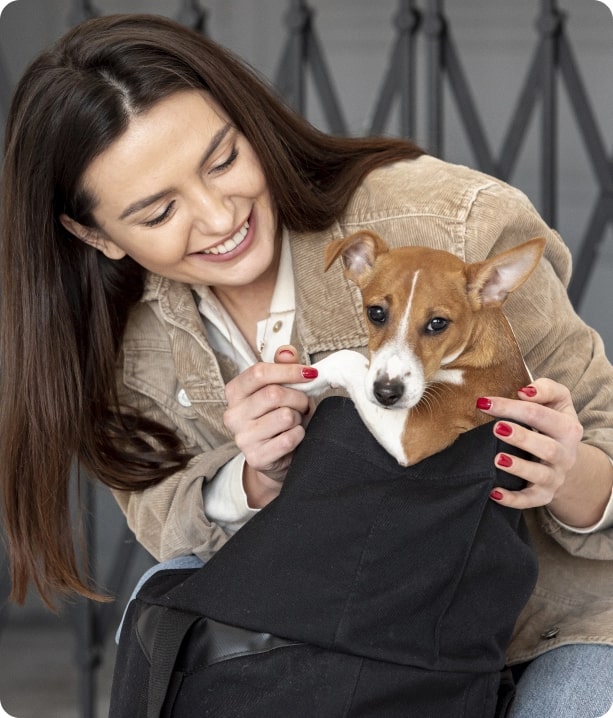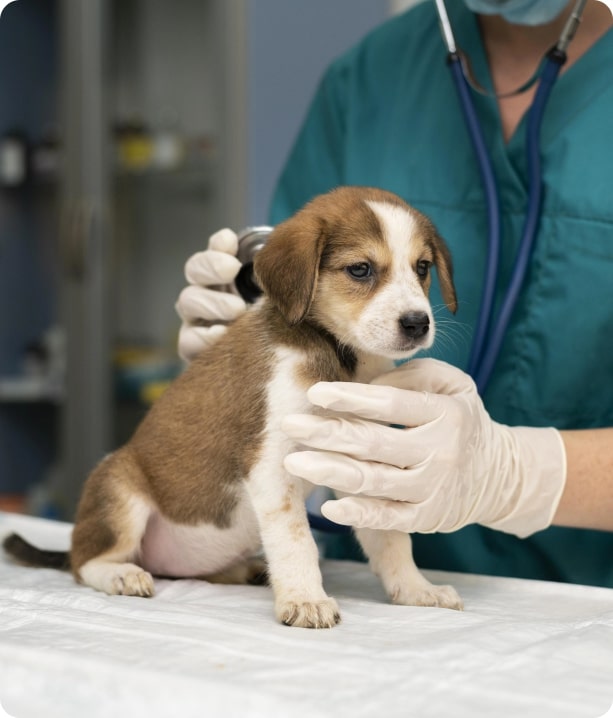Puppy Care
The normal gestation length in the bitch is a little longer than 2 months (65 days +/- 1 day). A whelping box should be placed in a quiet area that has low traffic and no drafts. The whelping box should be high enough to keep the puppies contained but allow the dam to enter and exit at will. Some people use a kiddie pool for smaller breed dogs. For medium and large breeds, a true whelping box would be better. A good example of the construction of a whelping box with an inner rail to prevent puppies being crushed can be found on Whelpwise.com.

Besides a whelping box, other supplies you should have on hand are: sharp scissors to cut umbilical cords and disinfectant to clean scissors; clean/new terry cloth hand towels to dry and stimulate puppies when they are removed from the amniotic sac; umbilical tape or suture material to tie off umbilical cords 1 cm from the abdominal wall; suction bulbs to remove amniotic fluid from the puppies’ nose and mouth; a puppy nursing bottle and milk replacer like KMR or Esbilac; a food or letter scale that weighs in ounces and a log book to record puppy weights; different color nail polish to paint a toe nail(s) of puppies to identify them (different colored cords or collars may also be used, however care must be taken to adjust the collars correctly to prevent puppies from getting a limb trapped or the collar too tight on their necks as they grow); clean towels for the whelping box area; and the contact information for your regular veterinarian and the nearest emergency pet hospital.
Two weeks before the dam’s anticipated due date, you should prepare the whelping area and allow her to get used to the surroundings. Her rectal temperature should also be taken each morning before the dam starts moving about the home. When progesterone drops below 2ng/ml, the body temperature will decrease roughly 2 degrees (around 98F). The dam will typically whelp within 24 hrs of this temperature decrease. Other signs of impending delivery include: increased nesting behavior (rooting in blankets, digging in the dirt, seeking out small dark spaces to lay down); milk in the mammary glands; clear, mucoid vulvar discharge; softening & elongation of the vulva; softening of the muscles around the base of the tail; restlessness and panting; decreased appetite; increased licking of the vulva.
Active labor begins when the dam is actively pushing and/or green-blackish discharge is noted from the vulva. This dark green discharge is due to separation of the placenta from the uterine wall. The presence of this discharge means the cervix is open and the dam is in stage two of active labor. If the dam becomes weak, depressed or non-responsive; if bright red blood is noted from the vulva; or if a puppy is not produced within one to two hours after the onset of active labor, you should seek veterinary assistance.
In the dog, it is normal for puppies to be born head first or rear legs first. If the dam is not cleaning and stimulating the puppies, you will need to remove the amniotic sac, tie off the umbilicus cord and dry off each puppy as they arrive. Once stimulated and breathing, each puppy should be placed on a nipple and allowed to nurse.
If the dam is caring for the litter, the puppies will only need a weight measurement twice daily to make sure they are gaining 10% of their body weight during this early stage. Each weight should be recorded for each puppy – hence the reason for identifying each puppy with a painted toe nail or colored collar. If a puppy is not gaining weight, supplemental feeding may be required.
Puppies are not able to regulate their own body temperature for the first 10 to 14 days of life. For this reason, the ambient temperature should be about 80F with humidity between 55-75% and a draft free environment established. A heating pad on low underneath clean towels or a heat lamp hanging above can serve as an external heat source on one end of the whelping box. This allows the puppies to find a temperature gradient where they are most comfortable.
Once the puppies are four weeks old, the weaning process can begin. Puppies should be offered a low sided pan that contains a slurry of milk replacer and ground up puppy food. We recommend Hills, Royal Canin or Black Bag Purina since these three companies produce diets based on years of research. Over the next two weeks, gradually increase the amount of puppy food and decrease the amount of milk replacer so that the puppies are eating more solid food and less milk. Some toy and tea cup breeders will sell a puppy after twelve weeks of age due to their small size and slower development of their liver and stomach capacity.

By law, all puppies sold in the state of Florida require a Health Certificate. This is typically done at eight weeks of age. The puppies are examined by a licensed veterinarian, a fecal sample is evaluated for parasites, their first vaccinations (Distemper combo and intranasal Bordatella) are given and they are dewormed. A copy of this certificate should accompany each puppy to his or her new home. Some breeders will also include a puppy care manual, recommendations for feeding/diet and when the puppy will be due for his next vaccination series. Breeders will also have a contract that outlines the agreement for the sale of the puppy, if there will be breeding rights or co-ownership of the puppy, and the stipulations regarding return of the puppy if there are specific health issues develop after the sale of the puppy.










